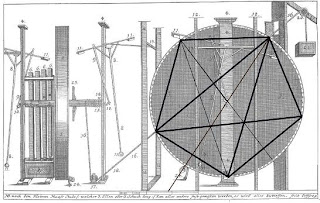I've mentioned Karl's involvement with Denis Papins before, but something occurred to me recently and I thought I'd post my thoughts here. Prior to Bessler's arrival Karl had funded the experiments of Denis Papin who was attemting to develop a steam engine. Papin stayed with the Landgrave for ten years, finally leaving, having been invited to London in 1707, he died there in 1712.
During his stay in Kassel, in 1704, he constructed a ship powered by his steam engine, mechanically linked to paddles. This made him the first to construct a steam-powered boat. How successful it was we don't know, but I suspect that it wasn't the complete solution Papin envisaged. He left his wife at Kassel when he went to London, possibly thinking he might return in the near future, and I've found a letter written in 1708, referring to Karl's hope that Papin would return to Kassel to continue his experiments. I suggest that it was perhaps news of Papin's death in 1712 that persuaded Karl to accommodate Bessler in his castle at that time. Curiously it was also this year that Newcomen exhibited his first Newcoment steam engine at Dudley castle in England.
Fischer von Erlach examined Bessler's wheel and must have been invited to the court by Karl - they couldn't just turn up uninvited. Professor 'sGravesend was also invited and I had always assumed that they were there to examine Bessler's wheel, but taking into account the fact that Papin had carried out experiments on the lake near to the castle, to build a steam-powered boat, I suspect they were there for another purpose. Leibniz had aided Papin in the development of a steam engine based on an invention by Thomas Savery, but this had proved problematic to construct. Details of the engine were published in 1707.
Both 'sGravesende and von Erlach, and indeed Desaguliers, were closely involved in the development of Captain Savery's engine, but this was eventually dropped in favour of the more powerful and reliable Newcomen steam engine. I suspect that Karl was motivated by thoughts of adapting either Newcomen's or Savery's engine to power the boat. To this end he sent Captain Weber to England in 1716 to obtain information on the Newcomen steam-engine, and he is also recorded as being the leader of the surveying team for a projected series of canals which were to enable Karlshafen to become an inland port. He was Karl's chief engineer and was charged with the task of draining the marshes to create canals. But Captain weber's efforts to try to learn the secrets of the Newcomen engine came to no avail, they were just as secretive as Bessler was.
Steam-powered boats? new canals? Steam engines? Put them together and knowing that the cascade at Kassel was powered by four man-made lakes above the start of the cascade, and therefore did not require Bessler's wheel to pump water to the top, and you have the beginnings of an attempt to produce steam-powered boats designed to ply the canals bringing goods to and from Karlshafen. Perhaps Karl had considered the possibility of trying to adapt Bessler's wheel for use in a boat?
JC

.jpg)






